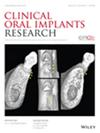Clinical Performance of Immediately Restored, Surface Modified Two‐Piece Zirconia Implants. A Prospective Case Series
IF 5.3
1区 医学
Q1 DENTISTRY, ORAL SURGERY & MEDICINE
引用次数: 0
Abstract
PurposeTo evaluate the short‐term success and survival rates of immediately restored surface modified two‐piece zirconia implants (CL).Material and MethodsA total of 23 patients had received CL implants (即刻修复、表面修饰两片式氧化锆种植体的临床表现。前瞻性案例系列
目的评价即刻修复的表面修饰二片式氧化锆种植体(CL)的近期成功率和成活率。材料和方法23例患者(n = 26)在上颌前、后牙和下颌骨愈合的拔牙部位接受CL种植体单牙置换。如果插入扭矩≥30 Ncm,则立即完成种植体修复(Type 3-4 A方案)。愈合3个月后提供闭合螺钉保留冠。在最终修复后的6个月和12个月评估种植体的生存和成功(即探针- bop,探针口袋深度- pd,粘膜萎缩- mr)。在6个月和12个月时评估患者报告的结果。结果5例患者种植体不能立即修复,4例患者在随访中丢失。成活率达80%。最后,我们对16例患者共16颗种植体进行了评估。在6个月和12个月时,平均BOP(- 3.3%±13.14%;8.3%±16.9%)、PD(- 0.15±0.48 mm; 0.08±0.48 mm)和MR(0.0±0.0 mm; 0.0±0.0 mm)值与基线(最终恢复)有轻微变化。没有观察到机械和技术并发症。患者在6个月和12个月时总体满意度较高。结论立即修复方案可能与早期种植体丢失的风险增加有关。
本文章由计算机程序翻译,如有差异,请以英文原文为准。
求助全文
约1分钟内获得全文
求助全文
来源期刊

Clinical Oral Implants Research
医学-工程:生物医学
CiteScore
7.70
自引率
11.60%
发文量
149
审稿时长
3 months
期刊介绍:
Clinical Oral Implants Research conveys scientific progress in the field of implant dentistry and its related areas to clinicians, teachers and researchers concerned with the application of this information for the benefit of patients in need of oral implants. The journal addresses itself to clinicians, general practitioners, periodontists, oral and maxillofacial surgeons and prosthodontists, as well as to teachers, academicians and scholars involved in the education of professionals and in the scientific promotion of the field of implant dentistry.
 求助内容:
求助内容: 应助结果提醒方式:
应助结果提醒方式:


